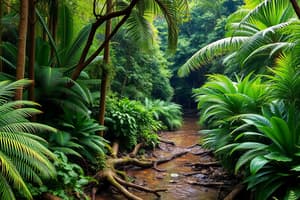Podcast
Questions and Answers
What type of wood is NOT mentioned as being sourced from tropical rainforests?
What type of wood is NOT mentioned as being sourced from tropical rainforests?
- Pine (correct)
- Rosewood
- Mahogany
- Teak
Which of the following is NOT a way indigenous people utilize tropical rainforests?
Which of the following is NOT a way indigenous people utilize tropical rainforests?
- Using mangroves for shelter
- Gathering fruit
- Building skyscrapers (correct)
- Hunting fish for trade
What is a consequence of deforestation related to tropical rainforests?
What is a consequence of deforestation related to tropical rainforests?
- Enhanced biodiversity
- Loss of forest recreation opportunities (correct)
- Improvement of soil quality
- Increased wildlife populations
How long can it take for biodiversity to be re-established in tropical rainforests after deforestation?
How long can it take for biodiversity to be re-established in tropical rainforests after deforestation?
Which of the following is a positive effect of visiting forests?
Which of the following is a positive effect of visiting forests?
What is a significant consequence of the enhanced greenhouse effect due to human activities?
What is a significant consequence of the enhanced greenhouse effect due to human activities?
How do tropical rainforests contribute to the water cycle?
How do tropical rainforests contribute to the water cycle?
What effect does the loss of tropical rainforests have on biodiversity?
What effect does the loss of tropical rainforests have on biodiversity?
What is a potential consequence of increased flooding due to the clearing of tropical rainforests?
What is a potential consequence of increased flooding due to the clearing of tropical rainforests?
What role do the roots of tropical rainforest trees play in their ecosystem?
What role do the roots of tropical rainforest trees play in their ecosystem?
What is one significant economic benefit of tropical rainforests (TRs) mentioned?
What is one significant economic benefit of tropical rainforests (TRs) mentioned?
What can be a consequence of the destruction of tropical rainforests on local economies?
What can be a consequence of the destruction of tropical rainforests on local economies?
Which of the following is a method proposed for the sustainable management of TRs?
Which of the following is a method proposed for the sustainable management of TRs?
What challenge is associated with the enforcement of laws in protected areas of TRs?
What challenge is associated with the enforcement of laws in protected areas of TRs?
How does the destruction of rainforests affect indigenous people?
How does the destruction of rainforests affect indigenous people?
Why is regulating forestry activities deemed important for TR management?
Why is regulating forestry activities deemed important for TR management?
What outcome can arise from the loss of rainforest ecosystems for indigenous cultures?
What outcome can arise from the loss of rainforest ecosystems for indigenous cultures?
What is a consequence of seeking immediate profits from resource extraction in TRs?
What is a consequence of seeking immediate profits from resource extraction in TRs?
Flashcards are hidden until you start studying
Study Notes
Uses of Forests by People
- Tropical Rainforests (TRs) are significant sources of raw materials such as timber for building and carpentry.
- Key hardwood types include teak, mahogany, and rosewood, valued for their strength, durability, and aesthetic appeal.
- Mangrove wood is utilized for constructing houses, jetties, boats, and as a source of fuel or charcoal.
- Beneath TRs, valuable metals and minerals like diamonds and iron can be found, leading to mining activities that clear forests using heavy machinery.
Habitation and Cultural Dependency
- Indigenous peoples rely on TRs for essential needs like food, water, shelter, and clothing.
- They practice fishing in mangroves, trading fish for staple foods like rice.
- Traditional houses, such as houseboats or temporary huts, often utilize materials sourced from mangroves.
Recreational Importance
- Forests provide opportunities for outdoor activities such as trekking, camping, and bird watching, fostering a connection with nature.
- Interacting with TRs contributes to improved mental and physical health.
- The calming effect of TRs promotes well-being and reduces stress.
Food Source
- Many staple foods, including bananas, mangoes, and various vegetables, originate from TRs.
- Indigenous people hunt wild animals, such as fish and deer, although this is often insufficient in developed societies.
- Some mangrove areas have transitioned into aquaculture farms to meet food demands.
Consequences of Resource Extraction from TRs
- Deforestation entails the permanent loss of TRs due to unsustainable logging, mining, and agricultural practices.
- Clearing TRs prevents the natural regeneration of vegetation, with biodiversity recovery taking up to 1,000 years.
Environmental Impacts
- Enhanced Greenhouse Effect: Deforestation releases stored carbon dioxide, increasing atmospheric greenhouse gases and contributing to global warming.
- Loss of Biodiversity: Human activities destroy habitats, risking extinction of many species that rely on specific environments to survive.
- Loss of Catchment Areas: TRs regulate the water cycle; tree loss leads to decreased moisture recycling, reduced rainfall, and exacerbated drought conditions.
- Increased Flooding and Soil Erosion: Without tree roots to stabilize soil, deforestation increases soil erosion, flooding risks, and sedimentation, degrading aquatic habitats and water quality.
Economic and Social Impacts
- Extractive industries provide short-term economic gains through timber and mineral sales but risk long-term resource depletion and economic instability.
- TR ecosystem services, such as climate regulation and pollination, impact agricultural productivity and local economies severely when lost.
- Ecotourism, a crucial revenue source for tropical nations, diminishes with forest destruction, leading to decreased tourist attraction.
Effects on Indigenous Peoples
- Indigenous communities face displacement from ancestral lands to facilitate logging, mining, and agricultural projects, threatening their livelihoods and cultural practices tied to forests.
- The alteration or destruction of TR ecosystems jeopardizes traditional knowledge and cultural heritage, posing significant risks to these communities.
Sustainable Management of TRs
- Protected Areas (PA): Governments establish laws to prevent illegal logging and poaching within these areas, enforcing strict penalties for violations. The efficiency of this approach often depends on funding and resources, especially in developing nations.
- Regulation of Forestry Activities: Balancing economic benefits with conservation efforts is crucial, as many communities depend on TR resource extraction for employment and revenue.
- Collaborations, such as partnerships between Brazilian authorities and logging companies, aim to facilitate controlled logging practices while ensuring TR conservation.
Studying That Suits You
Use AI to generate personalized quizzes and flashcards to suit your learning preferences.




